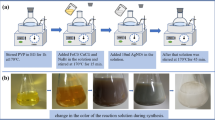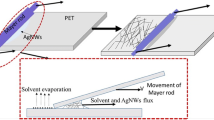Abstract
Silver nanowires (AgNWs) are promising candidate materials for flexible transparent conductive films (FTCFs), which are key parts in fabricating flexible optoelectronic devices. In the present work, we developed a modified polyol method, allowing simple and rapid synthesis of AgNWs with an ultra-high aspect ratio up to 2600, by adjusting the concentration of Cl− and Br−. Further, AgNWs–mixed cellulose ester membrane (MCE) FTCFs by vacuum filtration method were fabricated, exhibiting low sheet resistance of 6.53 Ω/sq and transmittance of 83.20%, which are comparable to those of typical indium tin oxide electrodes. Also, mechanical robustness results show the sheet resistance of the AgNWs–MCE film increased 16 and 2.8% after 300 times bending tests and 100 times of adhesion tests, respectively.








Similar content being viewed by others
References
Z. Zhang, Y. Gao, H. Luo, L. Kang, Z. Chen, J. Du, M. Kanehira, Y. Zhang, Z.L. Wang, Solution-based fabrication of vanadium dioxide on F:SnO2 substrates with largely enhanced thermochromism and low-emissivity for energy-saving applications. Energy Environ. Sci. 4(10), 4290–4297 (2011). https://doi.org/10.1039/C1EE02092G
L. Zhou, M. Yu, X. Chen, S. Nie, W.Y. Lai, W. Su, Z. Cui, W. Huang, Screen-printed poly (3, 4‐ethylenedioxythiophene): poly (styrenesulfonate) grids as ITO‐free anodes for flexible organic light‐emitting diodes. Adv. Func. Mater. 28(11), 1705955 (2018). https://doi.org/10.1002/adfm.201705955
H.-W. Chen, J.-H. Lee, B.-Y. Lin, S. Chen, S.-T. Wu, Liquid crystal display and organic light-emitting diode display: present status and future perspectives. Light Sci. Appl. 7(3), 17168–17168 (2018). https://doi.org/10.1038/lsa.2017.168
M. Hossain, K. Rahman, M. Islam, M. Akhtaruzzaman, H. Misran, M. Alghoul, N. Amin, Growth optimization of ZnxCd1-xS films on ITO and FTO coated glass for alternative buffer application in CdTe thin film solar cells. Opt. Mater. 86, 270–277 (2018). https://doi.org/10.1016/j.optmat.2018.09.045
Geological Survey, Mineral Commodity Summaries (Government Printing Office, Washington, D.C., 2016).
A. Elschner, W. Lövenich, Solution-deposited PEDOT for transparent conductive applications. MRS Bull. 36(10), 794 (2011). https://doi.org/10.1557/mrs.2011.232
S.I. Na, S.S. Kim, J. Jo, D.Y. Kim, Efficient and flexible ITO-free organic solar cells using highly conductive polymer anodes. Adv. Mater. 20(21), 4061–4067 (2008). https://doi.org/10.1002/adma.200800338
D. Zhang, K. Ryu, X. Liu, E. Polikarpov, J. Ly, M.E. Tompson, C. Zhou, Transparent, conductive, and flexible carbon nanotube films and their application in organic light-emitting diodes. Nano Lett. 6(9), 1880–1886 (2006). https://doi.org/10.1021/nl0608543
P. Wu, T.-X. Jiang, S. Suksaweang, R.B. Widelitz, C.-M. Chuong, Molecular shaping of the beak. Science 305(5689), 1465–1466 (2004). https://doi.org/10.1126/science.1098109
J.K. Wassei, R.B. Kaner, Graphene, a promising transparent conductor. Mater. today 13(3), 52–59 (2010). https://doi.org/10.1016/S1369-7021(10)70034-1
J.H. Lee, D.W. Shin, V.G. Makotchenko, A.S. Nazarov, V.E. Fedorov, Y.H. Kim, J.Y. Choi, J.M. Kim, J.B. Yoo, One-step exfoliation synthesis of easily soluble graphite and transparent conducting graphene sheets. Adv. Mater. 21(43), 4383–4387 (2009). https://doi.org/10.1002/adma.200900726
A.R. Rathmell, B.J. Wiley, The synthesis and coating of long, thin copper nanowires to make flexible, transparent conducting films on plastic substrates. Adv. Mater. 23(41), 4798–4803 (2011). https://doi.org/10.1002/adma.201102284
B. Zheng, Q. Zhu, Y. Zhao, Fabrication of high-quality silver nanowire conductive film and its application for transparent film heaters. J. Mater. Sci. Technol. 71, 221–227 (2021). https://doi.org/10.1016/j.jmst.2020.07.021
W. Xu, Q. Xu, Q. Huang, R. Tan, W. Shen, W. Song, Fabrication of flexible transparent conductive films with silver nanowire by vacuum filtration and PET mold transfer. J. Mater. Sci. Technol. 32(2), 158–161 (2016). https://doi.org/10.1016/j.jmst.2015.12.009
L. Hu, H.S. Kim, J.-Y. Lee, P. Peumans, Y. Cui, Scalable coating and properties of transparent, flexible, silver nanowire electrodes. ACS Nano 4(5), 2955–2963 (2010). https://doi.org/10.1021/nn1005232
M.R. Azani, H. Azin, T. Tomás, Benefits, problems, and solutions of silver nanowire transparent conductive electrodes in Indium Tin Oxide (ITO)-free flexible solar cells. Adv. Energy Mater. 10(48), 2002536 (2020). https://doi.org/10.1002/aenm.202002536
S. Lan, H.I. Shin, H.K. Kim, Electrically stable Ag nanowire network anodes densely passivated by a conductive amorphous InSnTiO layer for flexible organic photovoltaics. Appl. Phys. Lett. 117(12), 123303 (2020). https://doi.org/10.1063/5.0018165
S. Lee, J. Jang, T. Park, Y.M. Park, J.S. Park, Y.K. Kim, H.K. Lee, E.C. Jeon, D.K. Lee, B. Ahn, C.H. Chung, Electrodeposited silver nanowire transparent conducting electrodes for thin-film solar cells. ACS Appl. Mater. Interfaces 12(5), 6169–6175 (2020). https://doi.org/10.1021/acsami.9b17168
J. Jiu, T. Araki, J. Wang, M. Nogi, T. Sugahara, S. Nagao, H. Koga, K. Suganuma, E. Nakazawa, M. Hara, Facile synthesis of very-long silver nanowires for transparent electrodes. J. Mater. Chem. A 2(18), 6326–6330 (2014). https://doi.org/10.1039/C4TA00502C
R.M. Mutiso, M.C. Sherrott, A.R. Rathmell, B.J. Wiley, K.I. Winey, Integrating simulations and experiments to predict sheet resistance and optical transmittance in nanowire films for transparent conductors. ACS Nano 7(9), 7654–7663 (2013). https://doi.org/10.1021/nn403324t
N. Chou, Y. Kim, S. Kim, A method to pattern silver nanowires directly on wafer-scale PDMS substrate and its applications. ACS Appl. Mater. Interfaces. 8(9), 6269–6276 (2016). https://doi.org/10.1021/acsami.5b11307
S.M. Bergin, Y.-H. Chen, A.R. Rathmell, P. Charbonneau, Z.-Y. Li, B.J. Wiley, The effect of nanowire length and diameter on the properties of transparent, conducting nanowire films. Nanoscale 4(6), 1996–2004 (2012). https://doi.org/10.1039/C2NR30126A
Y. Xia, Y. Sun, Y. Yin, B. Mayers, T. Herricks, Uniform silver nanowires synthesis by reducing AgNO3 with ethylene glycol in the presence of seeds and poly (vinyl pyrrolidone). Chem. Mater. 14, 4736–4745 (2002). https://doi.org/10.1021/cm020587b
E.-J. Lee, M.-H. Chang, Y.-S. Kim, J.-Y. Kim, High-pressure polyol synthesis of ultrathin silver nanowires: electrical and optical properties. APL Mater. 1(4), 042118 (2013). https://doi.org/10.1063/1.4826154
S. Coskun, B. Aksoy, H.E. Unalan, Polyol synthesis of silver nanowires: an extensive parametric study. Cryst. Growth Des. 11(11), 4963–4969 (2011). https://doi.org/10.1021/cg200874g
R.R. Da Silva, M. Yang, S.-I. Choi, M. Chi, M. Luo, C. Zhang, Z.-Y. Li, P.H. Camargo, S.J.L. Ribeiro, Y. Xia, Facile synthesis of sub-20 nm silver nanowires through a bromide-mediated polyol method. ACS Nano 10(8), 7892–7900 (2016). https://doi.org/10.1021/acsnano.6b03806
B. Li, S. Ye, I.E. Stewart, S. Alvarez, B.J. Wiley, Synthesis and purification of silver nanowires to make conducting films with a transmittance of 99%. Nano Lett. 15(10), 6722–6726 (2015). https://doi.org/10.1021/acs.nanolett.5b02582
S. Bae, S.J. Kim, D. Shin, J.-H. Ahn, B.H. Hong, Towards industrial applications of graphene electrodes. Phys. Scr. 2012, 014024 (2012). https://doi.org/10.1088/0031-8949/2012/T146/014024 T146)
W. Zhou, A. Hu, S. Bai, Y. Ma, D. Bridges, Anisotropic optical properties of large-scale aligned silver nanowire films via controlled coffee ring effects. RSC Adv. 5(49), 39103–39109 (2015). https://doi.org/10.1039/C5RA04214C
Y. Ge, X. Duan, M. Zhang, L. Mei, J. Hu, W. Hu, X. Duan, Direct room temperature welding and chemical protection of silver nanowire thin films for high performance transparent conductors. J. Am. Chem. Soc. 140(1), 193–199 (2018). https://doi.org/10.1021/jacs.7b07851
Y. Sun, B. Mayers, T. Herricks, Y. Xia, Polyol synthesis of uniform silver nanowires: a plausible growth mechanism and the supporting evidence. Nano Lett. 3(7), 955–960 (2003). https://doi.org/10.1021/nl034312m
U. Lang, E. Müller, N. Naujoks, J. Dual, Microscopical investigations of PEDOT: PSS thin films. Adv. Func. Mater. 19(8), 1215–1220 (2009). https://doi.org/10.1002/adfm.200801258
Y.C. Jung, D. Shimamoto, H. Muramatsu, Y.A. Kim, T. Hayashi, M. Terrones, M. Endo, Robust, conducting, and transparent polymer composites using surface-modified and individualized double‐walled carbon nanotubes. Adv. Mater. 20(23), 4509–4512 (2008). https://doi.org/10.1002/adma.200801659
M. Kaempgen, G. Duesberg, S. Roth, Transparent carbon nanotube coatings. Appl. Surf. Sci. 252(2), 425–429 (2005). https://doi.org/10.1016/j.apsusc.2005.01.020
H. Gu, T.M. Swager, Fabrication of free-standing, conductive, and transparent carbon nanotube films. Adv. Mater. 20(23), 4433–4437 (2008). https://doi.org/10.1002/adma.200801062
S. Bae, H. Kim, Y. Lee, X. Xu, J.-S. Park, Y. Zheng, J. Balakrishnan, T. Lei, H.R. Kim, Y.I. Song, Roll-to-roll production of 30-inch graphene films for transparent electrodes. Nat. Nanotechnol. 5(8), 574 (2010). https://doi.org/10.1038/nnano.2010.132
Acknowledgements
This work was supported by National Natural Science Foundation of China (Grant Nos. 51505321 and 52075360).
Author information
Authors and Affiliations
Corresponding author
Ethics declarations
Conflict of interest
The authors declare that they have no known competing financial interests or personal relationships that could have appeared to influence the work reported in this paper.
Additional information
Publisher’s Note
Springer Nature remains neutral with regard to jurisdictional claims in published maps and institutional affiliations.
Rights and permissions
About this article
Cite this article
Zhai, X., Wang, W., Jia, J. et al. One-step synthesis of ultra-high aspect ratio silver nanowires for high-performance flexible transparent conductive films. J Mater Sci: Mater Electron 32, 15622–15632 (2021). https://doi.org/10.1007/s10854-021-06111-1
Received:
Accepted:
Published:
Issue Date:
DOI: https://doi.org/10.1007/s10854-021-06111-1




